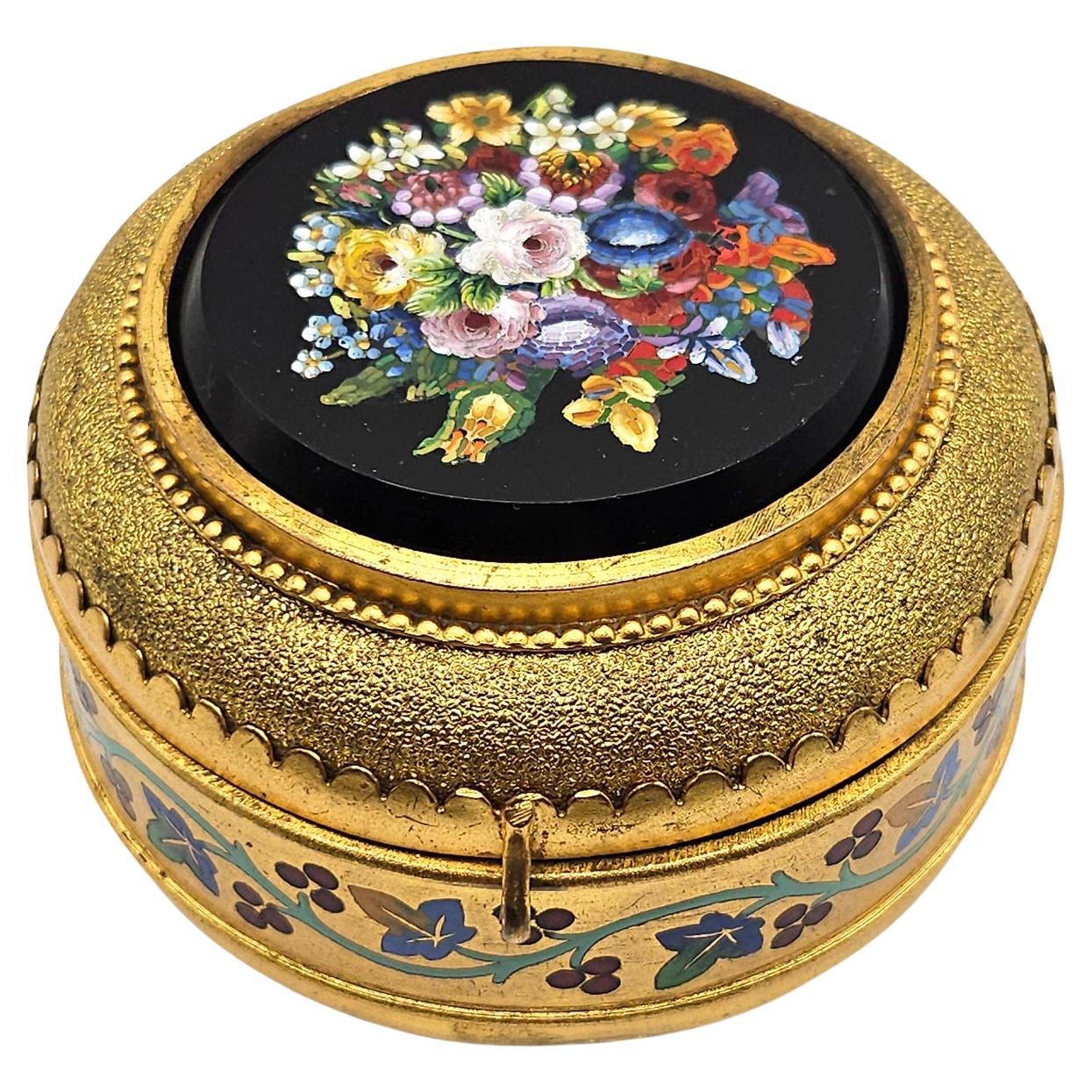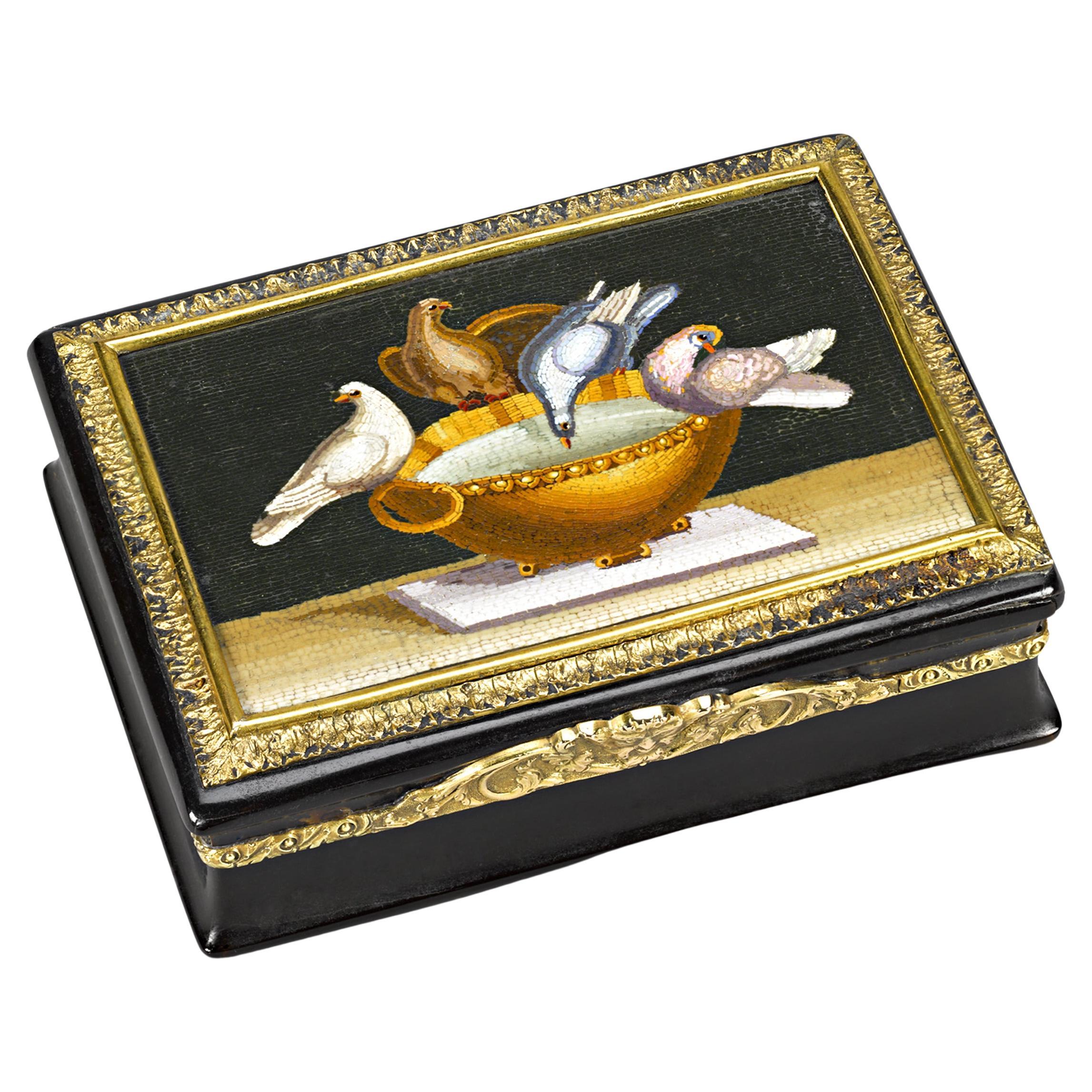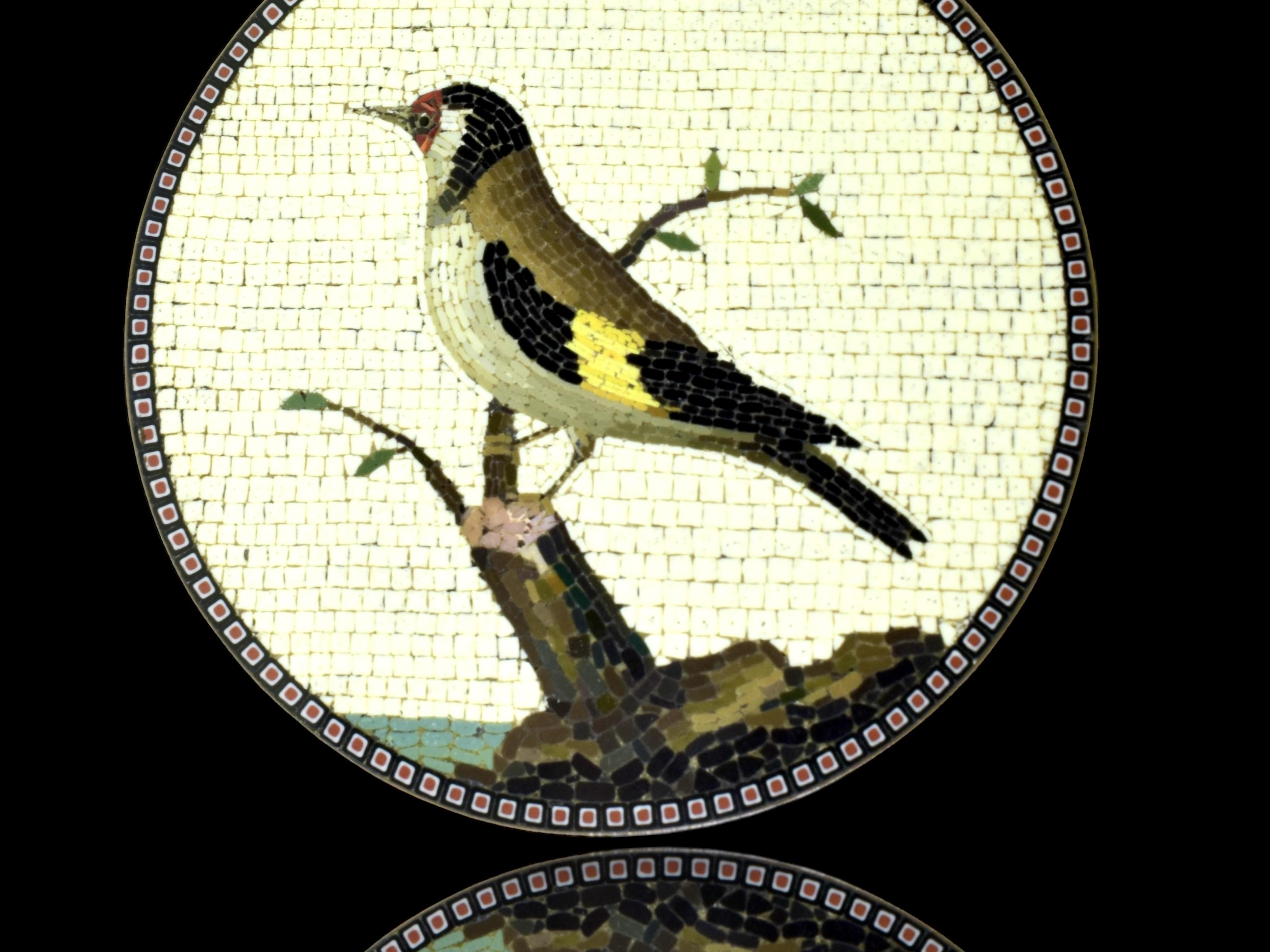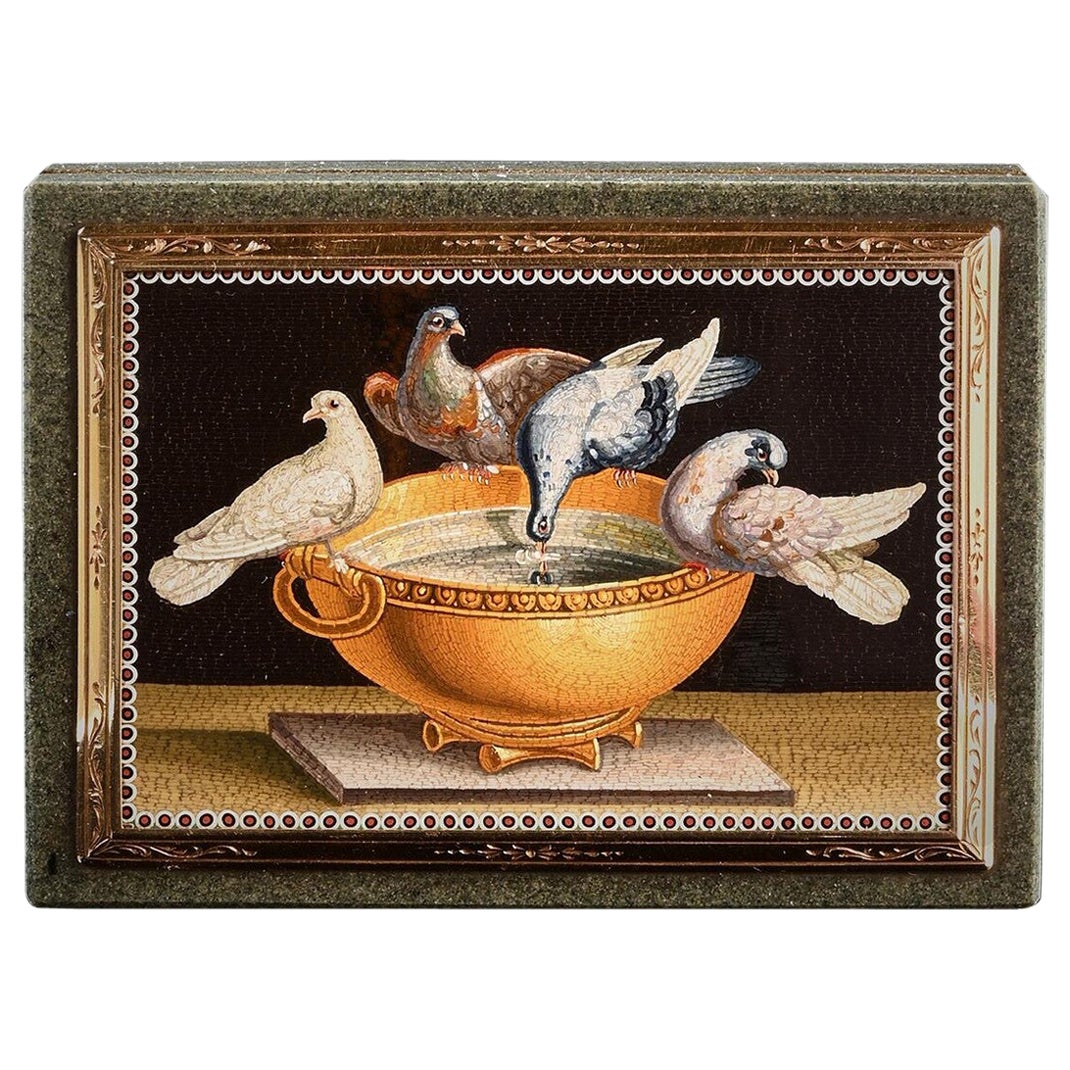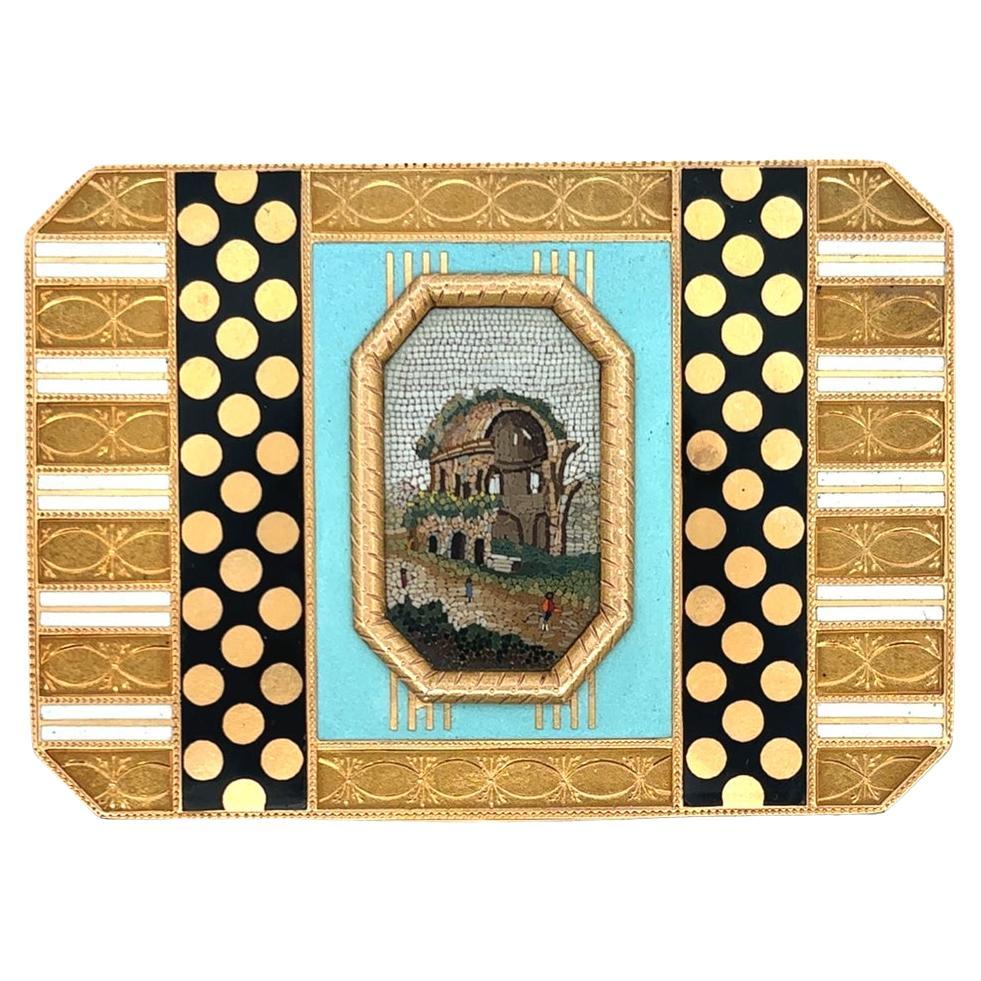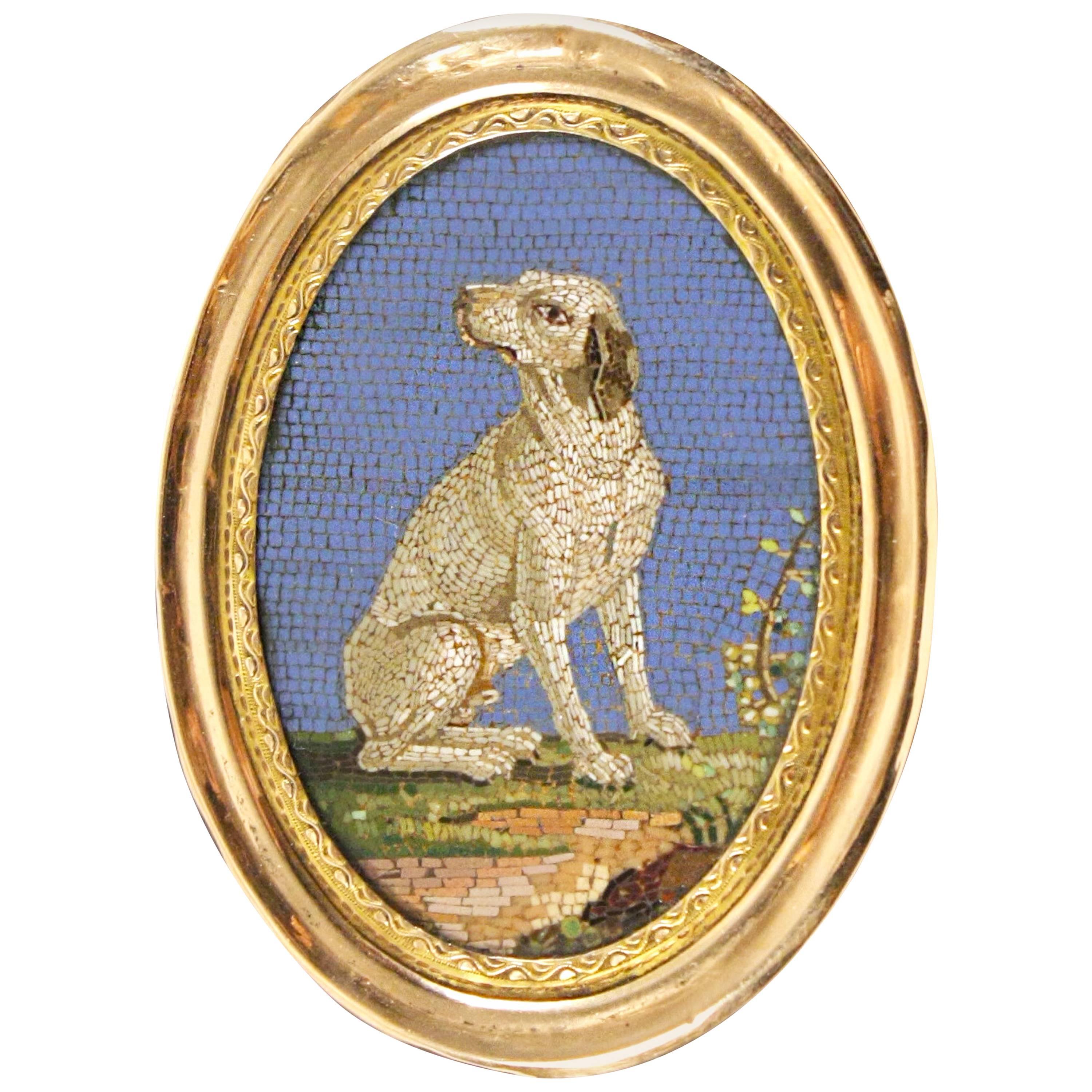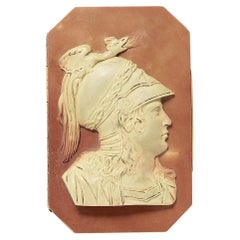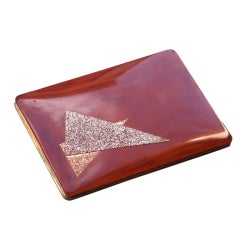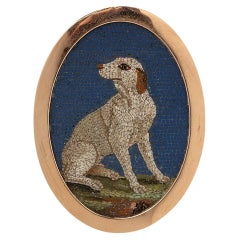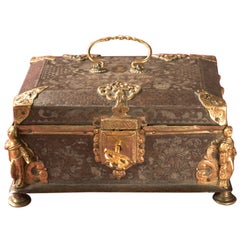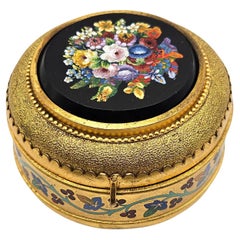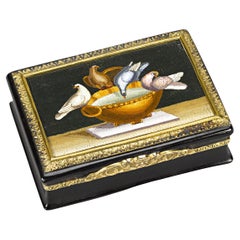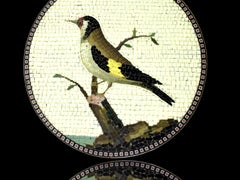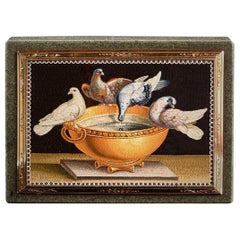Items Similar to Giacomo Raffaelli Micromosaic Box
Want more images or videos?
Request additional images or videos from the seller
1 of 7
Giacomo Raffaelli Micromosaic Box
Price Upon Request
Price Upon Request
Price Upon Request
Price Upon Request
Price Upon Request
Price Upon Request
Price Upon Request
Price Upon Request
Price Upon Request
Price Upon Request
About the Item
An Italian green granite box, with a micromosaic mounted in a two-color gold chased border. Depicted is a goldfinch (carduelis carduelis) on a branch with berries and overlooking the Mediterranean. The scene is surrounded by a millefiori border. By Giacomo Raffaelli (1753-1836) Rome, last quarter 18th century.
diameter: 8.4 cm height: 2.4 cm.
- Creator:Giacomo Raffaelli
- Metal:
- Dimensions:Diameter: 3.31 in (84 mm)
- Style:
- Place of Origin:
- Period:
- Date of Manufacture:last quarter of the 18th century
- Condition:
- Seller Location:Amsterdam, NL
- Reference Number:1stDibs: JU131222123358
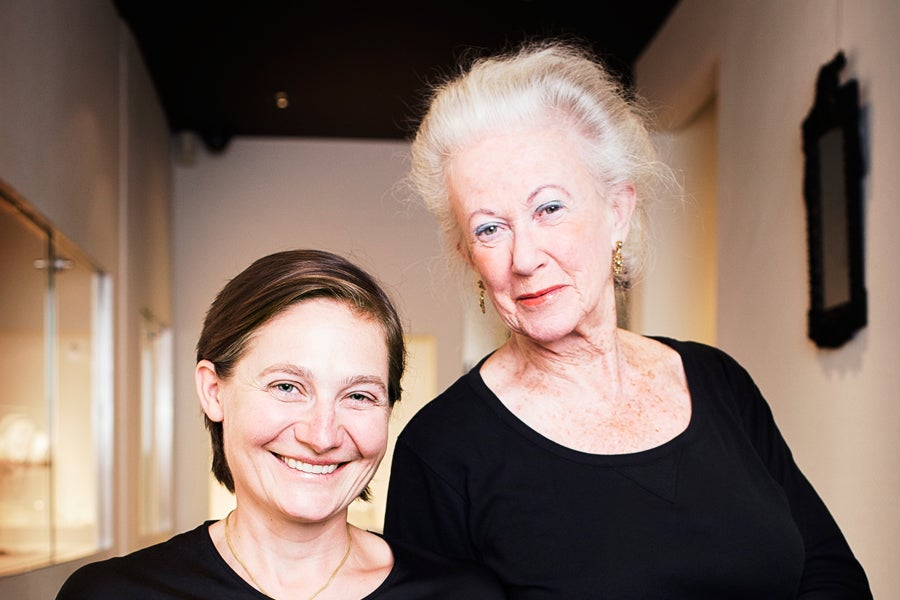
About the Seller
5.0
Recognized Seller
These prestigious sellers are industry leaders and represent the highest echelon for item quality and design.
Established in 1964
1stDibs seller since 2010
106 sales on 1stDibs
Typical response time: 6 hours
- ShippingRetrieving quote...Shipping from: Amsterdam, Netherlands
- Return Policy
More From This Seller
View AllA Silver Gilt and Yamsk Jasper Box of Achilles
Located in Amsterdam, NL
An octagonal box crafted from Yamsk Jasper, with each side featuring two layers of green and brown agate, set in a silver gilt mount. The front is adorned with a cameo of Achilles, his helmet embellished with a dragon motif.
weight: 50.49 g
dimensions: 2 x 6 x 3.8 cm
The Yamsk Jasper cameo snuff box, depicting Achilles in profile on the lid, is attributed to the Yekaterinburg Russian Imperial Lapidary, established in 1751, known for producing exquisite hardstone objects, many now part of the State Hermitage Museum's collection. The Russian Imperial Cabinet, responsible for overseeing Imperial family properties, managed lapidary production using precious stones from the Ural Mountains. The craftsmanship, material, and dimensions of the snuff box, along with its similarity to other Hermitage pieces, suggest it likely originated from the Yekaterinburg workshop. It was later fitted with 19th-century Russian snuff box components. The cameo likely draws inspiration from a model created by the renowned gem engravers Charles and William Brown, who also worked for Catherine the Great. A good visual comparison is offered by a modern cameo brooch...
Category
Antique Early 19th Century Russian Boxes and Cases
Materials
Jasper, Silver
JEAN DUNAND Enamel and Metal Cigarette Box
Located in Amsterdam, NL
A large metal box decorated with two triangle decorations in red and eggshell enamel on a brown back ground, signed: Jean Dunand, circa 1925.
Category
Early 20th Century French Art Deco Boxes and Cases
1800 Roman micro mosaic dog brooch
Located in Amsterdam, NL
An oval micro mosaic of a dog with a blue background in an 18 carat gold border, with a silver setting which can be either a brooch or a stand, Rome, circa 1800.
weight: 9.4 g
dimen...
Category
Antique 1790s Italian Brooches
Materials
18k Gold, Silver
Damascened Steel and Gold 16th Century Box
Located in Amsterdam, NL
A beautiful box made of fire gilt and damascened steel, completely original and in mint condition, with the original key, Italy or France, 16th century.
Category
Antique 16th Century Italian Boxes and Cases
Materials
22k Gold, Stainless Steel, Gold, Steel
An 18k Gold and Enamel Gucci Hazelnut Pill Box
By Gucci
Located in Amsterdam, NL
An 18-karat yellow gold pill box in the shape of a hazelnut engraved and and with brown enamel, signed: Gucci, Italy.
weight: 23.14 g
dimensions: 2.5 x 2 cm
Category
Vintage 1970s Italian Boxes and Cases
Materials
18k Gold, Enamel
18th Century Red Enamel Gold Vinaigrette
Located in Amsterdam, NL
A 'vinaigrette' in the shape of a small tobacco box. In 18- carat, two- colored, gold (rose and green), it is studded with flower decorations. Marked with two eagles, warranty mark f...
Category
Antique Late 18th Century Unknown Boxes and Cases
Materials
18k Gold, Gold, Enamel
You May Also Like
Antique Grand Tour Micro Mosaic Jewelry Box by Cesare Roccheggiani, Rome c. 1875
By Cesare Roccheggiani
Located in London, GB
A highly attractive and rare floral Grand Tour micromosaic jewelry or trinket box made by Cesare Roccheggiani in Rome, Italy, c. 1875.
This is a beautifully detailed micro-mosaic box. The panel in the lid depicts a lush bouquet of spring flowers, including roses, forget-me-nots, daffodils, buttercups and crocus, amongst others. These are described in brightly coloured stone micromosaic inlaid into a black surround, lending the piece wonderful contrast.
The more common subjects for similar micro mosaic boxes are architectural views of Rome; floral examples such as this are much harder to find.
The panel is mounted in a box gilded in 24 carat gold. Another distinctive feature is the granulated finish around the lid and to the underside of the box: it is most unusual and lends the piece a lovely texture.
A hand-painted champlevé enamel frieze wraps around the central body of the gilt metal box, depicting scrolling turquoise vines blooming with red berries along with blue, green and yellow vine leaves.
The interior is lined in the original silk and in very good original condition. The maker’s name ‘C. ROCCHEGGIANI ROMA’ is emblazoned in gold to the interior of the lid beneath the motif of a cross surmounted by a crown. The lining of both the lid and body are bordered with a ropetwist detail. The lid closes with hooked clasp, and the hinge is in good condition.
Cesare Roccheggiani was one of the most successful mosaicists in the late 19th century in Rome. He probably worked in Michelangelo Barberi’s workshop, and was in all likelihood related to Lorenzo Roccheggiani, a late eighteenth-century master mosaicist at the Vatican whose work included the altarpiece, Crucifixion of St. Peter after Guido Reni, and Nicolo Roccheggiani who worked on the Achilles Shield tabletop commissioned by Napoleon Bonaparte, and later gifted to Charles X of France, now in the collection of the Louvre.
Cesare Roccheggiani opened his premises on Via Condotti in Rome in 1874, and ran a production workshop including mosaicists, goldsmiths and other craftsmen. He was renowned as a source for fine quality Grand Tour mosaics...
Category
Antique Mid-19th Century Italian Grand Tour Jewelry Boxes
Materials
Stone, Metal
Micromosaic Snuff Box
Located in New Orleans, LA
This exceptional micromosaic snuff box represents the heights of this ancient art form. Depicting four doves sitting atop a bronze dish, the inse...
Category
Antique 19th Century Neoclassical Snuff Boxes and Tobacco Boxes
Materials
Bronze
$34,200
Giacomo Raffaelli signed & dated 1784, Rare Micromosaic Plaque of the Goldfinch
Located in Aspen, CO
Very rare 18th century micromosaic plaque of the Goldfinch. This circular plaque is 3 inches in diameter, the micromosaic is set in copper. On the verso, the piece is signed in cursi...
Category
Antique 1780s Italian George III Brooches
$19,160 Sale Price
20% Off
Free Shipping
Micromosaic Gold Mounted Jasper Snuff Box Early 19th Century Italian Gioacchino
Located in Benington, Herts
An Exceptional and Highly Important Micromosaic Gold Mounted Jasper Snuff Box, most probably by Gioacchino Barberi with the box likely by Moulinié, ...
Category
Antique Early 19th Century Italian Snuff Boxes and Tobacco Boxes
Materials
Gold
Antique Gold & Enamel Micromosaic Snuff Box
Located in New York, NY
Antique Gold & Enamel Micromosaic Snuff Box
An antique snuff box, decorated with a central micromosaic panel depicting ruins. The scene is framed by turquoise enamel, with gold-dot...
Category
Antique 19th Century Swiss Boxes and Cases
Materials
Gold, Enamel
Italian Gold-Mounted Micromosaic Snuff Box
Located in New York, NY
Italian micro mosaic plaque mounted within snuff box, depicting white and brown hound seated on grass.
Circle of Giacomo Raffaelli (1753-1836).
R...
Category
Antique Early 19th Century Italian Snuff Boxes and Tobacco Boxes
Materials
Glass
More Ways To Browse
Micromosaic Box
Antique Pill Box Jewelry
18k Gold Compact
Guilloche Enamel Case
Silver Cigarette Cases
Art Deco Gold Compact
Antique Pill Case
Van Cleef Jewelry Box
Clutch 18k Gold
Gold Cigarette Cases
Antique Gold Compact
Cartier Cigarette
Mughal Jade
Old Antique Jewelry Boxes
Boucheron Vintage Box
Gold And Diamond Pill Box
Cartier Cigarette Box
Guilloche Enamel Case Box
